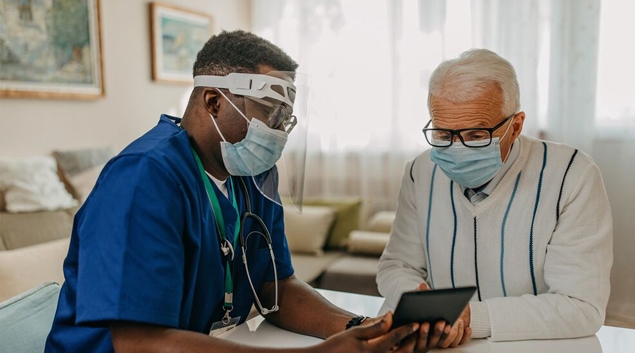
Home health medicaid is an government-funded program which covers millions Americans. It includes elderly people, children, as well as those with low or no income. It covers short-term home rehab, and long-term assistance in the home. State-to state differences are evident in coverage, services provided, qualifications required, and accessibility.
Does Medicare Cover Home Health Care?
Home health services can be provided by a variety of providers such as nurses, certified home health aides (CHHAs), and licensed clinical social workers. Medicare will pay for these services if the physician or agency that provides home care deems it necessary.
Do you need a caregiver in your home?
Home care can be a great option for seniors that want to live in their homes for as long a possible. But finding the right caregiver is not always easy. Finding the right match for your loved-one is very important. You can use a number of different tactics to find them.

How do I locate a caregiver within my community?
If you are looking for the right caregiver to meet your loved one's needs, then use the search tool offered by Medicare.
These tools allow you to narrow down your search and compare providers based on care types, services offered, and much more. The search tools will also provide you with a list of agencies that accept Medicare or the U.S. Administration on aging and other programs that provide care.
How much is home health care?
The cost of your home health care depends on a number of factors, including the type and level of service that you need. However, home health care averages about $3600 per month.
What are Medicare and Medicaid benefits?
Medicare and Medicaid are two of the most popular insurance options for seniors in need of home care. They both have different benefits. It is important to compare them both in order to find the best option for you.

What Are the Eligibility requirements for Medicare & Medicaid?
Medicare eligibility requires that a patient has been hospitalized for at least 3 consecutive days. Original Medicare Part A covers the medically necessary treatment a person receives while in a hospital, skilled nursing facility, or other healthcare facility.
When a patient leaves the hospital or nursing facility, they have 100 days to receive home health services after leaving the facility. If the patient still needs home health services after their 100 day period, they can receive them through Original Medicare Part B.
Does Medicare pay for caregivers in your home?
Medicare patients can hire a family or friend to be their home health aide. It is also known as "consumer-directed care" or "self directed care". Consumer-directed care allows you hire the home health care aide of choice and pay for it directly via your state's program.
FAQ
What are the three levels in health care facilities
General practice clinics are the first level. They provide basic medical services to patients who don't require hospital admission. They may also refer patients to other providers if required. This can include nurse practitioners, general practitioners, and midwives.
The second level of care is primary care centers, which provide outpatient services that include emergency care. These include hospitals, walk in clinics, urgent care centres, family planning clinics and sexual health clinics.
The third level of care is secondary care centres, which offer specialty services such as eye surgery, orthopaedic surgery, and neurosurgery.
What do you think are some of the most important issues facing public health today?
Many are victims of obesity, diabetes heart disease, and other diseases. These conditions result in more deaths per year than AIDS combined with car crashes and murders. Additionally, smoking, poor diet and inactivity can lead to high bloodpressure, stroke, asthma or other problems.
What is the difference of public health and health policies?
Both terms refers to the policies made by legislators or policymakers to change how health services are delivered. The decision to build a hospital can be made locally, nationally, or regionally. The same goes for the decision whether to require employers provide health insurance. This can be done by local, national or regional officials.
How can we improve our healthcare system?
We can improve health care by ensuring that everyone is provided high-quality medical care, no matter where they are located or what their insurance status.
To prevent children from contracting preventable diseases such as measles (MMR), it is essential that they receive all necessary vaccines.
It is important that we continue to work for lower costs of health care and ensure that it remains affordable to all.
What is the difference of a doctor and physician?
A doctor is an individual who has completed his/her training and is licensed to practice medicine. A physician refers to a medical professional that specializes in one area of medicine.
Statistics
- For instance, Chinese hospital charges tend toward 50% for drugs, another major percentage for equipment, and a small percentage for healthcare professional fees. (en.wikipedia.org)
- The healthcare sector is one of the largest and most complex in the U.S. economy, accounting for 18% of gross domestic product (GDP) in 2020.1 (investopedia.com)
- For the most part, that's true—over 80 percent of patients are over the age of 65. (rasmussen.edu)
- Foreign investment in hospitals—up to 70% ownership- has been encouraged as an incentive for privatization. (en.wikipedia.org)
- Price Increases, Aging Push Sector To 20 Percent Of Economy". (en.wikipedia.org)
External Links
How To
What are the 4 Health Systems?
Healthcare systems are complex networks of institutions such as hospitals and clinics, pharmaceutical companies or insurance providers, government agencies and public health officials.
The ultimate goal of the project was to create an infographic that would help people to better understand the US health system.
These are the key points
-
Healthcare spending is $2 trillion annually, representing 17% of the GDP. This is nearly twice the amount of the entire defense spending budget.
-
Medical inflation reached 6.6% for 2015, more than any other category.
-
Americans spend on average 9% of their income for health care.
-
There were more than 300 million Americans without insurance as of 2014.
-
Although the Affordable Care act (ACA) was signed into law, its implementation is still not complete. There are still significant gaps in coverage.
-
A majority of Americans believe that there should be continued improvement to the ACA.
-
The US spends more than any other nation on healthcare.
-
The total cost of healthcare would drop by $2.8 trillion annually if every American had affordable access.
-
Medicare, Medicaid, private insurers and other insurance policies cover 56%.
-
These are the top three reasons people don’t get insured: Not being able afford it ($25B), not having enough spare time to find insurance ($16.4B), and not knowing anything ($14.7B).
-
There are two types of plans: HMO (health maintenance organization) and PPO (preferred provider organization).
-
Private insurance covers the majority of services including doctors, dentists and prescriptions.
-
Public programs cover hospitalization, outpatient surgery, nursing homes, hospice care, long-term care, and preventive care.
-
Medicare is a federal program that provides health coverage to senior citizens. It covers hospital stays, skilled nursing facility stay, and home healthcare visits.
-
Medicaid is a program of the federal and state governments that offers financial assistance to low-income people and families who earn too much to be eligible for other benefits.